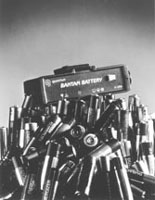Tech Tips
Select The "Right" Batteries
Although we tend to take them for granted, batteries are an integral part of photography. Virtually every camera developed in the last 10 years becomes merely a paperweight without voltage to keep its mechanisms ticking. Unlike the previous generation which required power for little more than metering functions, most of today's models are entirely battery dependent. Then there are the portable electronic flash units, which can consume even more batteries than cameras. While everyone is familiar
with alkalines, there are various other types available, each with its
own set of characteristics. Let's consider each one from a practical
perspective, especially the newer types, released over the past year
or so. |
|
Alkalines have plenty of appeal:
high energy capacity in relation to the (modest) price, fine low temperature
performance, and a shelf life of up to five years in cool storage. Each
year, new technology improves alkaline batteries, with every new generation
superior to its predecessors. Look for the latest versions such as Energizer
Advanced Design, Varta Photo AA Titanium Plus, Panasonic Plus, Duracell
ULTRA, or Kodak Photolife, for the very best performance (often 20 percent
better than older versions). Even today, some 67 percent of all batteries
sold are alkalines, and this is understandable given their exceptional
versatility. |
|
Note: The best alkalines will
provide double the number of flashes, and not all equipment was designed
to accept NiCds, for a variety of reasons, including the lower (1.2v vs.
1.5v) voltage in AA size. Check your Owner's Manual before making
a switch. The new special "Quick Charge" NiCds can be charged
in two to five hours. However, never attempt to charge ordinary NiCds
in a "quick charge" unit; overheating or an explosion may
result. |
|
Dispose of NiCd batteries with
caution--read the manufacturer's instructions--as the contents are
toxic. Some retailers will accept "dead" NiCds if you purchase
a new set, for return to the manufacturer who will recycle them. (Before
disposing of batteries of any type, check with your municipality as to
approved procedure.) Frankly, the greatest drawback of NiCds is the "memory
effect." If recharged before they are completely drained, they will
"remember" and may not subsequently accept a full charge.
Fortunately, "voltage depression" (the correct term) is a
temporary and reversible effect with the latest NiCd batteries. |
|
Touted as a superior rechargeable
battery, the Nickel-Metal Hydride (Ni-MH) types have been common in sizes
for portable computers and camcorders. Until recently, only one company,
Harding Energy Systems, offered such batteries in the AA size (1.2v vs.
1.5v like alkalines). Now two new and similar kits are available, with
four cells and a compact charger. The Kodak's Photolife (1450 mAh)
and Olympus B-30-SU (1300 mAh) kits are similar, and we expect to see
others soon. Environmentally friendly, they contain no cadmium, mercury,
lead, or lithium. Ni-MH uses a metal alloy negative electrode in place
of a cadmium electrode, allow- ing for greater energy storage (hydrogen,
in the form of hydrides). |
|
Note: With alkalines, recycle
times with flash begin to get longer and longer (20+ sec) as battery power
becomes lower. With most rechargeables, this does not occur and they tend
to "die" suddenly without that warning. |
|
For equipment which requires
AA batteries, look for the Eveready Energizer High Energy lithium employing
a lithium/iron disulfide chemical system. Optimized for use in photo equipment,
these were designed (with high current output) to meet the specific needs
of cameras and, particularly, electronic flash. Weighing a third less
(15g vs. 23g for alkalines), they deliver far more energy for less weight.
With flash, recycle times are shorter: averaging 7-8 sec vs. 10-15 sec
for alkalines, in my tests. Again, recycle times do not become extremely
long as the lithium batteries are close to exhaustion. This minimizes
the risk of missing a decisive moment while waiting patiently for the
"ready" light. |
|
Miniature Batteries.
If your camera takes button cells, its power demands are considerably
more modest. Consequently, it's well worth switching to lithiums
from the mercuric oxide (1.35v) types which are disappearing from the
market due to environmental legislation. However, many SLRs will not accept
the 3v lithiums; ask a photo dealer to check his compatibility charts
before any substitution. If necessary, switch to silver oxide cells instead,
purchased from a photo retailer. As with any chemistry, batteries intended
for hearing aids and other equipment will not provide suitable performance
with a camera. |
|
Other Power Sources.
Frequently used by press and wedding photographers, the accessory
battery packs for portable flash units meet professional demands. Similar
in concept to those in your car--sealed lead/acid cells, but filled with
a gelled electrolyte--these are also rechargeable. They offer far greater
capacity than any other type, for extended life and numerous flashes with
almost instant recycle (1 or 2 sec). Quantum Instruments, Lu-medyne, and
Dyna-Lite models are the most common but you'll find several other
brands, including those from flash manufacturers. (Various power packs
for studio flash are also available but these are beyond the scope of
this review.) |
|
A few camera manufacturers
offer remote battery packs for certain models of 35mm SLR cameras. (Check
the brochure or Owner's Manual for your camera or ask a knowledgeable
photo retailer.) The most common type includes a cord so you can keep
the battery pack in a warm pocket, a significant advantage in extreme
cold. Other types attach to the base of the camera, replacing a single
lithium cell (or four AAs) with more AA batteries for higher power capacity.
The latter accessory is less useful in cold weather but allows you to
use the more affordable battery types. Top Ten Battery Tips
Manufacturers/Distributors Duracell U.S.A. Dyna-Lite Eastman Kodak Eveready (Energizer) Harding Energy Systems Lumedyne, Inc. Olympus America Inc. Panasonic Industrial Co. Quantum Instruments, Inc. The Saunders Group Sigma Corporation of America Varta Batteries Inc. ZTS, Inc. |
- Log in or register to post comments











































